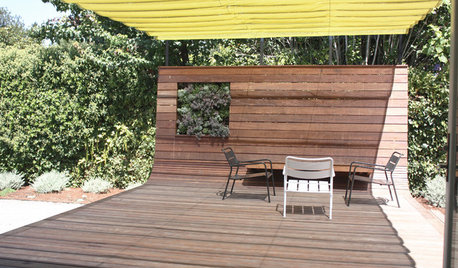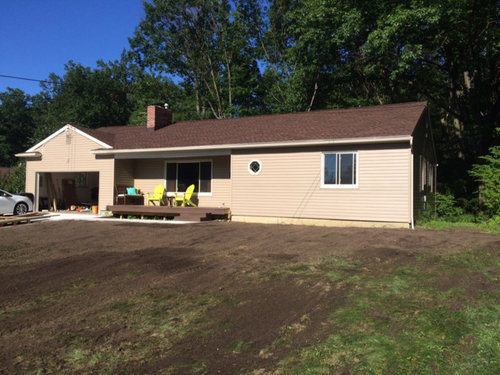Questions about planting new lawn and what to do next
vdeloren
8 years ago
Featured Answer
Sort by:Oldest
Comments (26)
yardtractor1
8 years agovdeloren
8 years agoRelated Discussions
New homeowner, questions about lawn and plants
Comments (2)I'll answer your plant questions: Pic 5 = Lilac (Can be grown as a small tree or shrub depending on your preference). Pic 6 = Boxwood. Appears to have been sunburnt/exposed to drought and poorly manicured (if ever). Cut off the dead stems, it may come back. Boxwood is cheap if you want to replace it. I'd suggest trimming them all to give them a uniform shape and promote center growth. Pic 6 = Weed. Clip all those seed heads off and throw them in the garbage before they spread everywhere! Then pull it or spray it. Congrats on the new place!...See MoreQuestions about replacing a dead lawn - what would you do?
Comments (18)St Augustine really doesn't need all that much water when it's established, but it will need more water as new sod. The trick with St. Augustine in the summer is not to scalp it.....we leave our mulching mower set up high. It does mean we have to mow a bit more often, but we have a front yard with grass, and my neighbors--whose lawn crew cuts the grass at about three inches---have next to nothing, even though they paid to resod a year ago. I can't afford to water my grass regularly and rarely ever do (and then only the front yard) unless it's looking really, really stressed. I want to also point out that St A is tolerant of light shade, but hates medium to deep shade and will not grow there at all. I'm not familiar with buffalo grass, but I'd suggest going with a ground cover under any heavy tree shade. StA grows all right in my front yard under a thinned out ash tree where the light is dappled, but there is none at all under the heavily branched ash tree in the backyard (it's on the utility easement and I wouldn't get near the power line with a saw if you paid me a million bucks). I grow ferns under there. Previous owner had black mondo grass. Good luck! If it were up to me, I'd just take the vast majority of my grass out....See MoreQuestions about starting my lawn over next year
Comments (4)Would it hurt your feelings to leave the rye out of your seed mix? Rye complicates the germination phase of a new lawn by tricking you into thinking all the seed is germinating in 7 days. Fescue germinates in about 10 days while KBG takes 15-20 days to germinate. Too many people stop with the daily irrigation after a week and the result is they never get much fescue or KBG. Next season practice good lawn care. Water deeply and infrequently, mow at the mower's highest setting, and fertilize on Memorial Day. You'll be doing the reno in late August so you'll use starter fert with that and then a regular fertilizer after the grass stops growing in November. Morph may have other thoughts, but if you got the soil test in the spring you would still have plenty of time to correct it. I am curious to see your CEC to see if you have sandy soil or something else....See MoreNewby Questions about new Citrus Plants
Comments (12)The citrus plants are responding well so far since being transplanted in the gritty mix. I have given each one a few showers with the hose. I gave them some vinegar mixed in with a gallon of water for each one. And I took off the tape and loosened the ties since this picture was taken. I am already planning what to order next time around, when the citrus I want become available again. ♡...See Moreyardtractor1
8 years agolast modified: 8 years agomorpheuspa (6B/7A, E. PA)
8 years agodchall_san_antonio
8 years agodchall_san_antonio
8 years agovdeloren
8 years agomorpheuspa (6B/7A, E. PA)
8 years agomorpheuspa (6B/7A, E. PA)
8 years agoyardtractor1
8 years agolast modified: 8 years agovdeloren
8 years agovdeloren
8 years agoyardtractor1
8 years agolast modified: 8 years agomorpheuspa (6B/7A, E. PA)
8 years agoyardtractor1
8 years agomorpheuspa (6B/7A, E. PA)
8 years agovdeloren
8 years agoyardtractor1
8 years agomorpheuspa (6B/7A, E. PA)
8 years agoyardtractor1
8 years agomorpheuspa (6B/7A, E. PA)
8 years agolast modified: 8 years agoyardtractor1
8 years agomorpheuspa (6B/7A, E. PA)
8 years agoyardtractor1
8 years agolast modified: 8 years agodchall_san_antonio
8 years ago
Related Stories

GARDENING GUIDESNo-Regret Plants: 5 Questions Smart Shoppers Ask
Quit wasting money and time at the garden center. This checklist will ensure that the plants you're eyeing will stick around in your yard
Full Story
EXTERIORSCurb Appeal Feeling a Little Off? Some Questions to Consider
Color, scale, proportion, trim ... 14 things to think about if your exterior is bugging you
Full Story
SAVING WATERHouzz Call: Are You Letting Go of Your Lawn?
Many facing a drought are swapping turf for less thirsty plantings. If you’re one of them, we’d like to hear about it
Full Story
DECKSA Family-Friendly California Yard Wises Up About Water
Pavers and unthirsty plants replace Kentucky bluegrass in a Menlo Park landscape for a family of 4
Full Story
GARDENING GUIDESNew Ways to Think About All That Mulch in the Garden
Before you go making a mountain out of a mulch hill, learn the facts about what your plants and soil really want
Full Story
ORGANIZINGPre-Storage Checklist: 10 Questions to Ask Yourself Before You Store
Wait, stop. Do you really need to keep that item you’re about to put into storage?
Full Story
REMODELING GUIDESConsidering a Fixer-Upper? 15 Questions to Ask First
Learn about the hidden costs and treasures of older homes to avoid budget surprises and accidentally tossing valuable features
Full Story
GARDENING GUIDESHow to Plant a New Lawn From Sod
Take the quick-start route to turf with sod; these installation guidelines will help ensure a healthy and long-lasting lawn
Full Story
GARDENING GUIDESHow to Plant a New Lawn From Seed
Choose from more grass varieties and save money over sod by starting your lawn from seed
Full Story
LANDSCAPE DESIGNGet Along With Less Lawn — Ideas to Save Water and Effort
Ditch the mower and lower your water bill while creating a feast for the eyes with diverse plantings and gathering places
Full Story




vdelorenOriginal Author